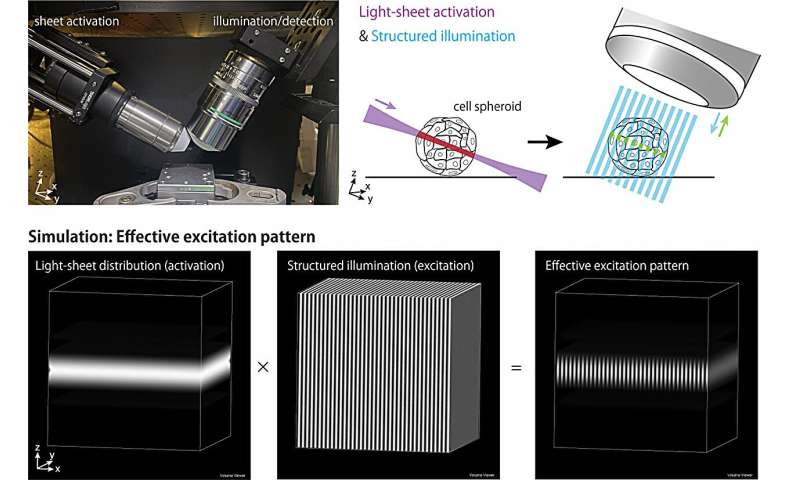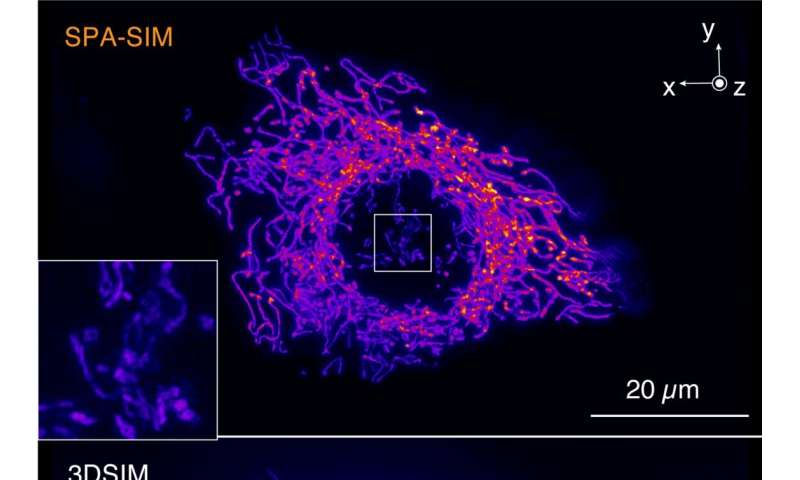This article has been reviewed according to Science X's editorial process and policies. Editors have highlighted the following attributes while ensuring the content's credibility:
fact-checked
peer-reviewed publication
trusted source
proofread
New super-resolution microscopy approach visualizes internal cell structures and clusters via selective plane activation

To study living organisms at ever smaller length scales, scientists must devise new techniques to overcome the so-called diffraction limit. This is the intrinsic limitation on a microscope's ability to focus on objects smaller than the wavelength of light being used.
Structured illumination microscopy is one of the super-resolution techniques that can help, by illuminating sinusoidal-patterned light on a sample to obtain a sharper image. However, background light from out-of-focus regions can still smear out the final picture.
In a study recently published in the journal Nature Methods, researchers from Osaka University demonstrated a new approach for super-resolution microscopy capable of observing structures inside a single cell or a cell cluster. This was accomplished by selecting only a desired plane to image using thin "light sheet" illumination, projected perpendicular to the lens, to switch on fluorophores.
"We show that selective-plane activation allows us to image dense microstructures inside cells with excellent sharpness not readily available previously," lead author of the study, Kenta Temma says. That is, sinusoidal "structured" light selectively excited only a thin plane where on-state fluorophores were localized, which allowed for background-free super-resolution imaging.
-

Configuration and imaging schemes of SPA-SIM (selective plane activation structured illumination microscopy). Simulated distribution of effective excitation pattern in SPA-SIM. Credit: K. Temma, R. Oketani et al -

3D projection images of a living HeLa cell expressing Skyla-NS on mitochondria observed with SPA-SIM(proposed method) and conventional 3DSIM. Credit: From Nature Methods (2024). DOI: 10.1038/s41592-024-02236-3
While some previous methods utilized random fluorescence emission from single molecules, or "donut" shaped second light source to deactivate or deplete fluorescent sources outside of a desired area, this new method can be gentler on cells that might be damaged by intense or long exposure to light.
The researchers believe that their approach is especially effective when trying to understand what is happening in living systems with spatial structure, which can often exhibit background light outside the desired focal plane. This includes organoids, which are artificial assemblies of different cell types meant to reproduce the behavior of actual body organs much better compared with collections of cells cultured on a flat petri dish.
"We anticipate that our technique will be useful for future biological studies of 3D cell clusters, including organoids," says senior author, Katsumasa Fujita. The same could apply to other complex biological systems.
The article, "Selective plane activation structured illumination microscopy," was published in Nature Methods.
More information: Kenta Temma et al, Selective-plane-activation structured illumination microscopy, Nature Methods (2024). DOI: 10.1038/s41592-024-02236-3
Journal information: Nature Methods
Provided by Osaka University



















